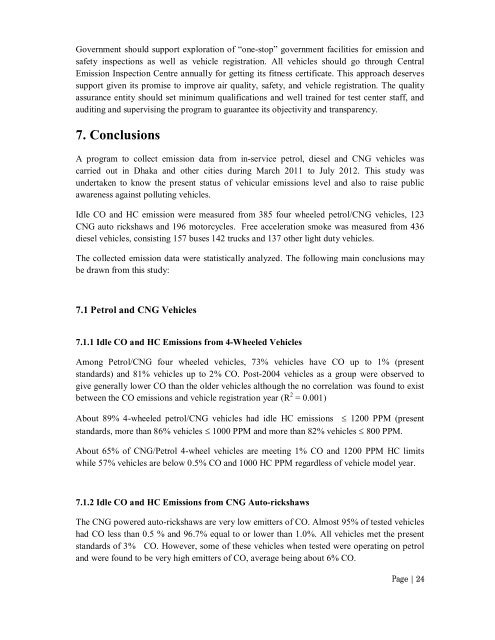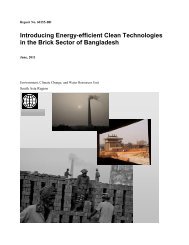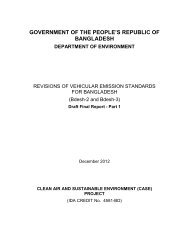Emission Inspection of In-use Vehicle in Bangladesh - CASE
Emission Inspection of In-use Vehicle in Bangladesh - CASE
Emission Inspection of In-use Vehicle in Bangladesh - CASE
You also want an ePaper? Increase the reach of your titles
YUMPU automatically turns print PDFs into web optimized ePapers that Google loves.
Government should support exploration <strong>of</strong> “one-stop” government facilities for emission and<br />
safety <strong>in</strong>spections as well as vehicle registration. All vehicles should go through Central<br />
<strong>Emission</strong> <strong><strong>In</strong>spection</strong> Centre annually for gett<strong>in</strong>g its fitness certificate. This approach deserves<br />
support given its promise to improve air quality, safety, and vehicle registration. The quality<br />
assurance entity should set m<strong>in</strong>imum qualifications and well tra<strong>in</strong>ed for test center staff, and<br />
audit<strong>in</strong>g and supervis<strong>in</strong>g the program to guarantee its objectivity and transparency.<br />
7. Conclusions<br />
A program to collect emission data from <strong>in</strong>-service petrol, diesel and CNG vehicles was<br />
carried out <strong>in</strong> Dhaka and other cities dur<strong>in</strong>g March 2011 to July 2012. This study was<br />
undertaken to know the present status <strong>of</strong> vehicular emissions level and also to raise public<br />
awareness aga<strong>in</strong>st pollut<strong>in</strong>g vehicles.<br />
Idle CO and HC emission were measured from 385 four wheeled petrol/CNG vehicles, 123<br />
CNG auto rickshaws and 196 motorcycles. Free acceleration smoke was measured from 436<br />
diesel vehicles, consist<strong>in</strong>g 157 b<strong>use</strong>s 142 trucks and 137 other light duty vehicles.<br />
The collected emission data were statistically analyzed. The follow<strong>in</strong>g ma<strong>in</strong> conclusions may<br />
be drawn from this study:<br />
7.1 Petrol and CNG <strong>Vehicle</strong>s<br />
7.1.1 Idle CO and HC <strong>Emission</strong>s from 4-Wheeled <strong>Vehicle</strong>s<br />
Among Petrol/CNG four wheeled vehicles, 73% vehicles have CO up to 1% (present<br />
standards) and 81% vehicles up to 2% CO. Post-2004 vehicles as a group were observed to<br />
give generally lower CO than the older vehicles although the no correlation was found to exist<br />
between the CO emissions and vehicle registration year (R 2 = 0.001)<br />
About 89% 4-wheeled petrol/CNG vehicles had idle HC emissions 1200 PPM (present<br />
standards, more than 86% vehicles 1000 PPM and more than 82% vehicles 800 PPM.<br />
About 65% <strong>of</strong> CNG/Petrol 4-wheel vehicles are meet<strong>in</strong>g 1% CO and 1200 PPM HC limits<br />
while 57% vehicles are below 0.5% CO and 1000 HC PPM regardless <strong>of</strong> vehicle model year.<br />
7.1.2 Idle CO and HC <strong>Emission</strong>s from CNG Auto-rickshaws<br />
The CNG powered auto-rickshaws are very low emitters <strong>of</strong> CO. Almost 95% <strong>of</strong> tested vehicles<br />
had CO less than 0.5 % and 96.7% equal to or lower than 1.0%. All vehicles met the present<br />
standards <strong>of</strong> 3% CO. However, some <strong>of</strong> these vehicles when tested were operat<strong>in</strong>g on petrol<br />
and were found to be very high emitters <strong>of</strong> CO, average be<strong>in</strong>g about 6% CO.<br />
Page | 24




